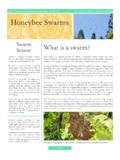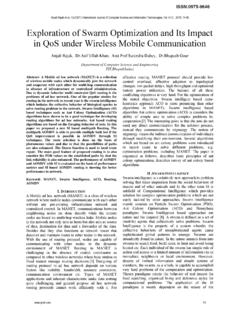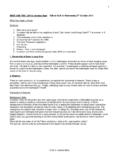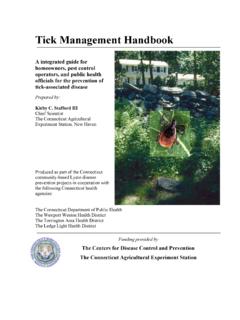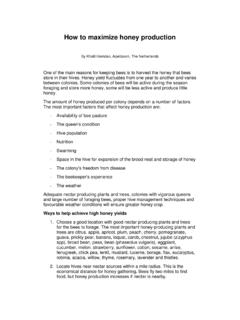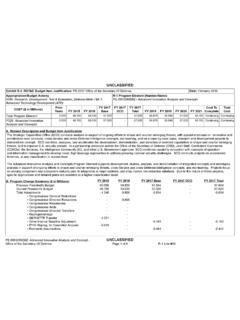Transcription of MAAREC Publication 3.4 SWARMING - CONTROL
1 SWARMING remains one of the greatest bee manage-ment problems in the production of honey or theproviding of pollination services. SWARMING representsthe natural method of increase of the honey bee the cause of SWARMING is not known, severalfactors that are connected with swarm biology serve asthe basis of preventive manipulations. CONTROL of swarm-ing, once the honey bee colony has begun swarmpreparations, involves more extensive manipulationand rather critical timing. These require time andknowledge on the part of the prevention and, when necessary, the CONTROL ofswarming is good bee management. Colonies thatswarm do not store extra surplus honey or provide agood working population for pollination of a crop. In-crease of colony number and colony division should beplanned and not the result of capture of one s ownswarms.
2 With an understanding of SWARMING and someefforts to prevent it, beekeeping will be improved and itwill become more enjoyable and more BIOLOGYS warming normally occurs in strong populous colo-nies. The first apparent preparation in SWARMING isthe laying of fertile eggs by the queen in the specialqueen cups that are normally present. With subse-quent hatching of the egg and development of queenlarvae (provided they are not destroyed), queen cellsare capped 8 days later and ready to emerge in another7 or 8 days depending upon weather and other development of the several queen cells, a seriesof behavioral changes occur in colonies. The queenloses from 1/3 to 1/2 of her normal body weight. Thefield bees do less work and may congregate at the hiveentrance and/or on the lower frames.
3 More drones areoften reared; fewer and fewer eggs are laid by thequeen. Finally, prior to leaving the hive, the workersengorge themselves on honey and nearly cease nor-mal flight swarm normally emerges from the parent hiveduring nice weather and settles on some support suchas tree limb, shrub or building. This clustering occursa varying distance from the former hive often withinsight of the parent hive. Each swarm consists of thecolony queen, and a proportion (1/2 to 2/3rds) of theMAAREC Publication 2000workers and drones of the former colony. One or moresealed queen cells are present in the original may remain only a few minutes to severaldays at the cluster location before moving to a newdarkened cavity suitable for nest building.
4 The netresult after hatching of a queen cell in the former hiveis two active colonies in two separate BEE SWARMST hree factors that are connected with SWARMING arethe brood and adult population as related to room withinthe hive, the amount and distribution of availablequeen substance (a chemical produced by the queen)and the hive environment as it relates to the above twofactors. The measures listed below are all aimed atinsuring that queen cells, the first step in SWARMING ,are not started. In most years attention to each factorwill keep the incidence of SWARMING at a very low andtolerable level. Provision of plenty of room (not just adequate room) forqueen egg laying in the brood nest. Two full depth hivebodies may not be sufficient room for brood rearing instrong colonies; one hive body is never adequate inhealthy colonies (comb honey production usually in-volves one hive body with intensive managementincluding the cutting of queen cells).
5 Reversal of broodchamber hive bodies every 8-10 days helps insureadequate brood room when 1-1/2 or 2 brood chambercolonies are maintained. All brood nest combs shouldbe in good condition for egg laying, contain a minimumof drone comb and should not possess large amounts ofstored honey or pollen after late April (all coloniesshould have 15-20 pounds of honey to protect againstspring starvation). Provision of sufficient nectar storage space. Some superspace should always be available for nectar from lateApril to mid-August. When supers are added it issometimes necessary to entice bees into working inthem immediately. Bottom supering (adding supers ontop of brood area below other supers) and baiting of newsupers (raising a frame or two of capped brood intosuper added or by dripping syrup on the comb face) isrecommended.
6 Full supers of foundation should not beadded until the honey flow has begun or late in theseason after the greatest danger of SWARMING haspassed (after mid-June). SWARMING - CONTROL Colonies should receive maximum sunlight early in theseason but have shade if the temperature becomes highlater. Afternoon shaded apiary sites are entrances facing the morning sun or south arepreferable. Hives painted white are useful in tempera-ture regulation by the colony. Sufficient ventilation should be present. Winter en-trance blocks are best removed early in the bodies can be staggered to aid ventilation. Someapiaries with poor air circulation could benefit if colo-nies are supplied with a deep ventilating bottom board.(If steps are taken to aid ventilation, insure thatrobbing does not become prevalent.)
7 Young queens heading all colonies. This is a definiteaid in swarm prevention. All requeening should bedone with stock with low SWARMING tendencies. Queenscan be marked with paint on the top of the thorax tohelp find them. Most bee locations will support queenrearing activities so the beekeeper can rear replace-ment stock. Removal of queen cells as they are started. If the queencells are advanced or completed, removal will onlypostpone SWARMING and the time necessary to look forcells is seldom worth the effort except for the a colony is just beginning queen cells, providing moreroom and adjusting the hive environment combinedwith the removal of all cells will help. It will be neces-sary to examine the colony again in a week to 10 daysto insure that more cells are not MEASURESOnce a colony begins rearing a number of queens andthey are not discovered by the beekeeper until welladvanced, more drastic action than explained abovewill be necessary to stop the colony from all involve some work, the surplus honey crop orproper pollination service are well worth the basic techniques are given below with somevariations of each.
8 All queen cells should be destroyedbefore proceeding with one of the swarm CONTROL tech-niques listed. Removal of the Queen - Dequeening a colony rearingqueen cells is effective swarm CONTROL but often takesconsiderable time searching for the queen. After queenremoval, the colony is left for 7 to 9 days and then thequeen is placed in a cage and put back into the colonyafter all queen cells are again destroyed. Variations ofthis technique include the destroying of the originalqueen and introducing a newly purchased or rearedqueen or adding a queen cell 7 to 9 days later or, finally,cutting out all queen cells except one which is allowedto emerge, mate and head the colony. Removal of thequeen for swarm CONTROL always produces a break inbrood rearing.
9 This can affect the honey surplus storedfrom summer nectar sources, but late spring flowssuch as tulip poplar will not suffer from lack of bees. Removal of the Brood - By dividing a colony, thebeekeeper obtains the net result of SWARMING but doesso at his convenience and without the work of swarmcapture or risk of missing or being unable to capturethe swarm. To divide a colony, 3-5 frames of brood withclinging bees are removed from those colonies thatbegin rearing queens. These frames are placed in asmall hive (nucleus) and a queen cell or new queenadded. The unit is placed on a new location and theentrance reduced to help prevent robbing and aid fieldworker bees in orienting to the new location. Framesof brood from colonies requiring swarm CONTROL mayalso be added to weaker colonies to equalize colonystrength provided disease is not variation of brood removal is that of Snelgrove whoadvocates separation of adult nurse and field beeswithin the hive (and thus brood rearing and nectarripening areas).
10 His technique calls for placing ofqueen and 1 or 2 frames of unsealed brood in anotherwise empty super on bottom. A special doublescreen with 8 wedge openings (4 top and 4 bottomopenings, one to a side) is then put on top of this remaining brood frames are placed on top of thedouble wedge screen is opened to permit entry-exit intothe top brood hive body (the normal entrance to lowerbrood chamber and honey super always remains open)and then after 7 to 8 days it is closed. Another topopening on the side or back of the hive is opened fornormal egress from the top hive body. At closing of theoriginal top hive body entrance the lower wedge open-ing of the same side is opened in addition to the new tophive body entrance.

